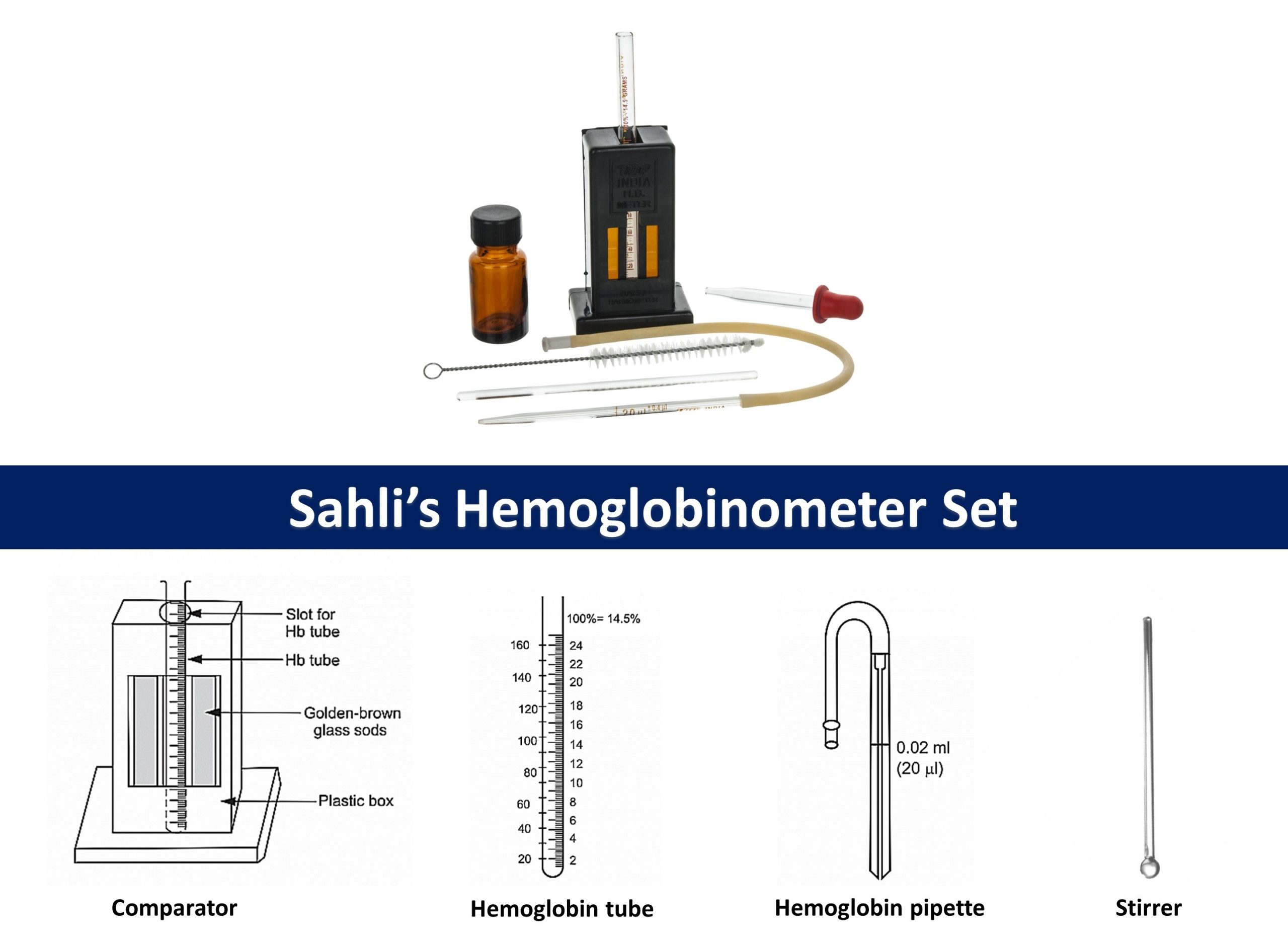- HbA: 96-98%, Composed of two alpha(α) and two beta(β) globin chains.
- HbA2: 1.5-3.5%, Composed of two alpha(α) and two delta(δ) globin chains.
- HbF: < 1.0%, Composed of two alpha(α) and two gamma(γ) globin chains.
Hemoglobin can combine with other substances, some normally and some abnormally and can also occur as:
- Oxyhemoglobin: Oxygen combined with hemoglobin.
- Carboxyhemoglobin: Carbon monoxide (CO) combined with hemoglobin.
- Carbaminohemoglobin: Carbon dioxide (CO2) combined with hemoglobin.
- Methemoglobin: Iron oxidized from its ferrous state to ferric state.
- Sulfhemoglobin: Sulfur combined with the hemoglobin.
- Cyanmethemoglobin: Methemoglobin bonded to cyanide ions.
Methods for Hemoglobin Estimation:
The different methods used for the estimation of hemoglobin can be divided as follows:
- Visual methods:
- Sahli’s method
- Dare method
- Haden method
- Wintrobe method
- Tallqvist method
- Spectrophotometric methods:
- Oxyhemoglobin method
- Cyanmethemoglobin method
- Gasometric method
- Automated hemoglobinometry
- Other methods:
- Alkaline-hematin method
- Specific gravity method
- Lovibond Comparator method
Sahli’s method for hemoglobin estimation
Sahli’s method, also called as acid hematin method is the visual comparator method for the estimation of hemoglobin. As visual comparison may lead to unacceptable imprecision and accuracy, this method is not recommended nowadays and the use of spectrophotometric methods like Cyanmethemoglobin method is preferred to it.
Principle:
When the blood is added to dilute hydrochloric acid (HCl), hemoglobin present in the RBCs is converted into brown-colored acid hematin. The acid hematin solution is further diluted until it’s color matches exactly with the permanent standard brown glass compared by direct vision.
Requirements:
Specimen:
Capillary or venous blood. Venous blood should be anticoagulated with 1.5-1.8 mg EDTA per mL of blood and mixed immediately.
Instruments:
- Sahli’s hemoglobinometer
It is a set of devices that includes a comparator, hemoglobin tube, hemoglobin pipette, and stirrer.

- Comparator: It is a rectangular plastic box with a slot in the middle which accommodates a hemoglobin tube. Brown standard glasses are provided on either side of the slot for color matching. White opaque glass is present at the back to provide uniform illumination.
- Hemoglobin tube: Sahli’s graduated hemoglobin tube is graduated in one side in gram percentage (g%) from 2 to 24, and on the other side in percentage (%) from 20 to 140. The tube is also called Sahli-Adams tube.
- Sahli’s pipette or hemoglobin pipette: It contains only one mark at 20μl or 0.02ml. Unlike WBC and RBC diluting pipettes, it contains no bulb.
- Stirrer: It is a thin glass rod used for stirring the mixture inside the hemoglobin tube.
Reagents:
- N/10 Hydrochloric acid (HCl): Mixing 36 grams HCl in distilled water to 1 liter gives 1 N HCl. Diluting it 10 times will give N/10 HCl.
- Distilled water
Procedure:
- Ensure that the hemoglobinometer tubes and pipette are clean and dry.
- Fill the hemoglobinometer tube with N/10 HCl up to its lowest mark i.e. 2 g% or 10% mark with the help of a dropper.
- Take blood up to mark in the Sahli’s pipette (20 μl). Wipe the extra blood outside the pipette and deliver it to N/10 HCl in the hemoglobin tube.
- Mix and leave it for 10 minutes in order for a complete conversion of hemoglobin to hematin.
- Add distilled water drop by drop and stir till color matches with the standard glass of the comparator.
- Take the reading at lower meniscus, which directly gives the hemoglobin concentration in 100 ml of blood.
Advantages and Disadvantages of Sahli’s method
Advantages:
- Easy to perform and convenient.
- Not very time consuming. Can be performed within maximum 15 minutes.
- Reagents and apparatus are cheap and easily available. Reagents are less harmful.
- Can be used in mass surveys. Doesn’t require electricity.
Disadvantages:
- Acid hematin is a suspension, not a true solution. So, some turbidity may result.
- This method can’t measure all hemoglobins. It estimates only oxyhemoglobin and reduced hemoglobins. But carboxyhemoglobin, methemoglobin and sulfhemoglobin (which all constitute about 2-12% of total hemoglobin) are not converted to acid hematin.
- HbF is not converted to acid hematin. Therefore, Shali’s method is not suitable for measuring hemoglobin in infants upto 3 months.
- WBC counts >100,000/cumm will produce turbid solution of acid hematin, which will increase the hemoglobin report by 5-10%.
- Chances of visual error are high. Color of acid hematin also fades gradually.
- The color of glass standard may fade over time.
References:
- Pal, G.K., 2006. Textbook Of Practical Physiology-2Nd Edn. Orient Blackswan.
- Ghai, C.L., 2012. A textbook of practical physiology. JP Medical Ltd.
- A. V. Naigaonkar. A Manual Of Medical Laboratory Technology.
- Cheesebrough, M., 1998. District laboratory practice in tropical countries, part II. Cambridgeshire Tropical Health Technology, Cambridge, UK, 231.
- Laboratory Procedures in Clinical Hematology By United States. Department of the Army
- Mohan, H. and Mohan, S., 2011. Practical Pathology for Dental Students. JP Medical Ltd.
It is a set of devices that includes a comparator, hemoglobin tube, hemoglobin pipette, and stirrer.

- Comparator: It is a rectangular plastic box with a slot in the middle which accommodates a hemoglobin tube. Brown standard glasses are provided on either side of the slot for color matching. White opaque glass is present at the back to provide uniform illumination.
- Hemoglobin tube: Sahli’s graduated hemoglobin tube is graduated in one side in gram percentage (g%) from 2 to 24, and on the other side in percentage (%) from 20 to 140. The tube is also called Sahli-Adams tube.
- Sahli’s pipette or hemoglobin pipette: It contains only one mark at 20μl or 0.02ml. Unlike WBC and RBC diluting pipettes, it contains no bulb.
- Stirrer: It is a thin glass rod used for stirring the mixture inside the hemoglobin tube.


Be the first to comment